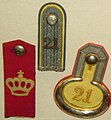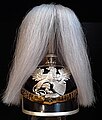2nd Badisches Dragoon Regiment No. 21
The 2nd Badische Dragoon Regiment No. 21 was a cavalry association of the Grand Ducal Baden Army that had existed since 1850 and was part of the Prussian Army from 1871 .
history
On January 6, 1850 (Foundation Day) the establishment of a 2nd cavalry regiment with a garrison in Mannheim was ordered. It replaced the 2nd Dragoon Regiment , which was disbanded due to mutiny during the revolution of 1848 . In 1851 the regiment moved to Bruchsal , with the 1st Squadron stationed in Rastatt . On January 10, 1855, the association was formed to form the 2nd Dragoons Regiment and with the appointment of Margrave Maximilian as head of the regiment , on September 20, 1856, it was named 2nd Dragoons Regiment "Margrave Maximilian" . The move to Karlsruhe followed in 1862 , with the 1st Squadron still in Rastatt. This only changed in 1867 when this squadron moved to Durlach. According to the military convention , the association was incorporated into the Prussian Army on July 1, 1871 and was given the name of the 2nd Badisches Dragoon Regiment "Margrave Maximilian" No. 21 . The margrave died in 1882 and the regiment was named 2nd Badisches Dragoon Regiment No. 21 from June 29, 1882 . From 1871 to 1890 the 1st Squadron was again in Rastatt and then in Schwetzingen.
On June 16, 1913, Grand Duchess Hilda von Baden was appointed head of the regiment without any change in the association's name.
German war
In the association of the VIII Federal Army Corps in the federal execution against Prussia. Skirmishes at Hundheim and Gerchsheim .
Franco-German War
1870 Participation in the Battle of Weißenburg and the Battle of Wörth . Then assigned to the siege troops in front of Strasbourg . The regiment rode an attack at Nuits . In 1871 it was turned off for the siege of Belfort . On April 4, 1871 return to the home garrisons.
Operations in the colonies
- 1900 China: one officer and 14 NCOs and dragoons of the regiment are participants in the expeditionary force to put down the Boxer Rebellion
- 1904/06 German South West Africa : two officers and 46 NCOs and dragoons of the regiment take part in the suppression of the Herero uprising.
First World War
In August 1914, the regiment took part in border battles in Lorraine . Then advance to the Rhine-Marne Canal . After the withdrawal order in September, the regiment took part in the race to the sea and was deployed on the right wing of the 1st Army until the end of October and then in the area of the new 4th Army . In November 1914, it was moved to the Eastern Front with fighting in Russian Poland, near Lodz , near Brzeziny in northern Poland, in Courland and Lithuania .
Whereabouts
On January 14, 1919, the regiment returned to Bruchsal, after which it was demobilized and disbanded.
In the Reichswehr , the 3rd Squadron of the 18th Cavalry Regiment in Ludwigsburg took over the tradition . The 2nd Division of Cavalry Regiment 18 continued in the Wehrmacht .
Commanders
| Rank | Surname | date |
|---|---|---|
| Colonel | Theodor Hilpert | January 10, 1850 to February 17, 1854 |
| Colonel | August Hecht | February 18 to September 8, 1854 |
| Lieutenant Colonel / Colonel | Heinrich von Freystedt | September 30, 1854 to September 19, 1860 |
| Lieutenant Colonel / Colonel | Karl von Freydorf | September 20, 1860 to July 19, 1866 |
| Lieutenant Colonel / Colonel | Hippolyt Wirth | July 20, 1866 to July 14, 1871 |
| Major / Lieutenant Colonel | Oskar von Strachwitz | July 15 to November 3, 1871 (in charge of the tour) |
| Lieutenant Colonel / Colonel | Oskar von Strachwitz | November 4, 1871 to April 28, 1879 |
| Lieutenant Colonel / Colonel | Karl von Heister | April 29, 1879 to June 11, 1886 |
| Colonel | Paul von Bause | June 12, 1886 to July 14, 1890 |
| Colonel | Karl von Uslar-Gleichen | July 15, 1890 to April 17, 1895 |
| Lieutenant Colonel / Colonel | Siegmund von Longchamps-Berier | April 18, 1895 to May 1, 1899 |
| Lieutenant Colonel / Colonel | Konrad Kühne | May 2, 1899 to January 26, 1903 |
| Lieutenant Colonel / Colonel | Reinhold von Eben | January 27, 1903 to October 17, 1907 |
| Colonel | Wilhelm von Uslar-Gleichen | October 18, 1907 to April 19, 1910 |
| Lieutenant Colonel / Colonel | Hunold von Plettenberg-Oevinghausen | April 20, 1910 to April 17, 1913 |
| Lieutenant Colonel / Colonel | Eginhard Eschborn | April 18, 1913 to January 20, 1918 |
| major | Curt Heyl | January 21, 1918 to January 1919 |
Uniformity
The dragoons wore a blue tunic and anthracite trousers. The tunic was equipped with Swedish lapels .
The regiment's badge color was yellow. The cuffs, the stand-up collar, the epaulette fields and passers-by were of this color . The buttons and fittings were made of brass . A white bandolier with a black cartridge ran from the left shoulder to the right hip . The bandolier and cartridge were not worn with the evening suit and formal suit. The helmet was decorated with the Baden griffin in nickel silver. Scale chains and the tip of the helmet were made of brass. For the parade a white (for the musicians a red) horsehair bush was put on instead of the tip. The national cockade was yellow-red as was the team's lance flag. The non-commissioned officers' lance flag was yellow with a red Baden griffin. The belt was white and had a pin buckle.
According to AOK of February 14, 1907, the field gray uniform M 1910 was introduced for field service from 1909/10. In this uniform, the straps and boots were natural brown, the helmet was covered by a reed-colored cover. The bandolier and cartridge were no longer worn.
literature
- Albert Benary : History of the 2nd Badischer Dragoon Regiment No. 21. Ed. By the association of officers of the former 2nd Bad. Dragoon Rgt. No. 21, Verlag Bernard & Graefe, Berlin 1941.
- Hans-Joachim Harder: Military history handbook Baden-Württemberg. Published by the Military History Research Office , Kohlhammer , Stuttgart 1987, ISBN 3-17-009856-X .
- Jürgen Kraus : The German Army in World War I: Uniforms and Equipment. 1914 to 1918. Verlag Militaria, Vienna 2004 (= catalogs of the Bavarian Army Museum , 2), ISBN 3-9501642-5-1 .
- Adolf Legde: History of the 2nd Badischer Dragoon Regiment No. 21. Berlin 1893 Digitized in the Internet archive
- Hugo FW Schulz: The Prussian Cavalry Regiments 1913/1914. Podzun-Pallas Verlag, Friedberg 1985, licensed edition Weltbild Verlag, Augsburg 1992, ISBN 3-89350-343-9 .
Web links
Individual evidence
- ^ Günter Wegmann (Ed.), Günter Wegner: Formation history and staffing of the German armed forces 1815-1990. Part 1: Occupation of the German armies 1815–1939. Volume 3: The occupation of the active regiments, battalions and departments from the foundation or list until August 26, 1939. Biblio Verlag, Osnabrück 1993, ISBN 3-7648-2413-1 , p. 83.








